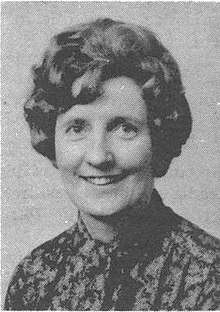Anne Anderson (researcher)
Anne Barbara Michie Anderson (10 February 1937 – 11 February 1983) was a Scottish reproductive physiologist, researcher, lecturer, and author.[1] Her major contributions were for her research in reproductive physiology. In the last decade of her life, she broadened this to encompass more about women's health generally, including doing clinical trials and working with people focusing in on what would become evidence-based medicine.
Anne Anderson | |
|---|---|
 | |
| Born | Anne Barbara Michie Anderson 10 February 1937 |
| Died | 11 February 1983 (aged 46) |
| Nationality | Scottish |
| Occupation | Reproductive physiologist |
Early life, education, early career
Anne Anderson was born in Forres, Scotland on 10 February 1937. She received her M.B. degree in 1960 from the University of Aberdeen and was awarded her M.D. from the same institution in 1965 for her basic science research on the birth process.
Work on birth process
Anderson moved to the Tenovus Institute in Cardiff alongside Professor Alec Turnbull with whom she had been working. In 1970, Anderson was appointed clinical lecturer in obstetrics and gynecology at the Welsh National School of Medicine.[1] Anderson was awarded her Ph.D. in 1972, again for work focused around the birth process.[1] When Turnbull moved to the University of Oxford in 1973, Anderson moved with him and was appointed clinical lecturer in obstetrics and gynecology.[1] In 1978, she was appointed University Lecturer at the University and Honorary Consultant in Clinical Reproductive Physiology in the John Radcliffe Hospital, Oxford. She was also appointed a fellow of St Hilda's College, Oxford.[1]
In Oxford, Anderson continued her research the birth process in sheep and humans and also took on studies of the causes and management of preterm labor, gynecological endocrinology, and infertility.[2][3][4][5][6][7][8] Anderson started one of the first menopause clinics in Oxford, within the Nuffield Department of Obstetrics and Gynaecology, at John Radcliffe Hospital. In addition to doing her laboratory and clinical work, Anderson served on the editorial boards of the Journal of Endocrinology and the British Journal of Obstetrics and Gynaecology.
In 1980, Anderson was elected chairman of the Blair Bell Research Society, and in 1981 she was elected as a fellow of the Royal College of Obstetricians and Gynaecologists, London.
Later work
Anderson had an active interest in women's health, co-editing the first edition (1983) of Women's Problems in General Practice with Ann McPherson.[9] Anne also contributed to Effectiveness and Satisfaction in Antenatal Care (1982), edited by Murray Enkin and Iain Chalmers, and was discussing, with Marc Keirse and Iain Chalmers, the possibility of co-editing a companion volume on Effective Care in Labour and Delivery.[10] [11] However, Anderson's illness and premature death from breast cancer at age 46 ended her involvement. Iain Chalmers, Murray Enkin and Marc Keirse went on to publish Effective Care in Pregnancy and Childbirth (ECPC) in 1989, dedicating the book in part to Anderson.[12] Effective Care in Pregnancy and Childbirth, through its systematic approach to assessing the research literature, is widely acknowledged to have led to development of a similar project for all of medicine and health, the Cochrane Collaboration.
Legacy
The Anne Anderson Award is presented each year by the Cochrane Collaboration.[13] Recipients are women and are selected based on emotional and cognitive intelligence, serving as an inspiration to others, evidence of cumulative accomplishment, originality and independence of thought, personal qualities, team building, leadership and mentorship. The recipient of the Anne Anderson Award receives a plaque from the Cochrane Collaboration honoring her contributions. The cash award of US$3000 is designated by the recipient to assist one woman from a low resource setting with her Cochrane Collaboration activities.
References
- BMJ (1983). "Obituary". BMJ. 286: 1068–1070. doi:10.1136/bmj.286.6370.1068.
- Anderson, AB; Webb, R; Turnbull, AC (1981). "Oestrogens and parturition". J Endocrinol. 89 Suppl: 103P–117P. PMID 7017055.
- Anderson, AB; Haynes, PJ; Fraser, IS; Turnball, AC (1978). "Trial of prostaglandin-synthetase inhibitors in primary dysmenorrhoea". Lancet. 311 (8060): 345–348. doi:10.1016/s0140-6736(78)91077-2. PMID 75391.
- Anderson, AB; Sklovsky, E; Sayers, L; Steele, PA; Turnbull, AC (1978). "Comparison of serum oestrogen concentrations in post-menopausal women taking oestrone sulphate and oestradiol". Br Med J. 1 (6106): 140–142. doi:10.1136/bmj.1.6106.140. PMC 1602815. PMID 620226.
- Anderson, AB; Gennser, G; Jeremy, JY; Ohrlander, S; Sayers, L; Turnbull, AC (1977). "Placental transfer and metabolism of betamethasone in human pregnancy". Obstet Gynecol. 49 (4): 471–474. PMID 857211.
- Anderson, AB; Haynes, PJ; Guillebaud, J; Turnbull, AC (1976). "Reduction of menstrual blood-loss by prostaglandin-synthetase inhibitors". Lancet. 307 (7963): 774–776. doi:10.1016/s0140-6736(76)91612-3. PMID 56590.
- Anderson, AB; Flint, AP; Turnbull, AC (1975). "Mechanism of action of glucocorticoids in induction of ovine parturition: effect on placental steroid metabolism". J Endocrinol. 66 (1): 61–70. doi:10.1677/joe.0.0660061. PMID 1172518.
- Turnbull, AC; Patten, PT; Flint, AP; Keirse, MJ; Jeremy, JY; Anderson, AB (1974). "Significant fall in progesterone and rise in oestradiol levels in human peripheral plasma before onset of labour". Lancet. 303 (7848): 101–103. doi:10.1016/s0140-6736(74)92337-x. PMID 4130306.
- McPherson, Ann; Anderson, Anne (1983). Women’s Problems in General Practice. Oxford: Oxford University Press.
- Enkin, M; Chalmers, I (1982). Effectiveness and Satisfaction in Antenatal Care. Clinics in Developmental Medicine series no. 81-82. London: Heinemann Medical Books. ISBN 978-0901260598.
- Reynolds, LA; Tansey, EM (2005). "Prenatal Corticosteroids for Reducing Morbidity and Mortality after Preterm Birth" (PDF). Wellcome Witnesses to Twentieth Century Medicine. Archived from the original (PDF) on 2 April 2015. Retrieved 17 February 2015.
- Chalmers, I; Enkin, M; Keirse, MJNC (1989). Effective Care in Pregnancy and Childbirth. Oxford: Oxford University Press. ISBN 978-0192615589.
- "Anne Anderson Award". The Cochrane Collaboration. 26 October 2014. Retrieved 22 February 2015.